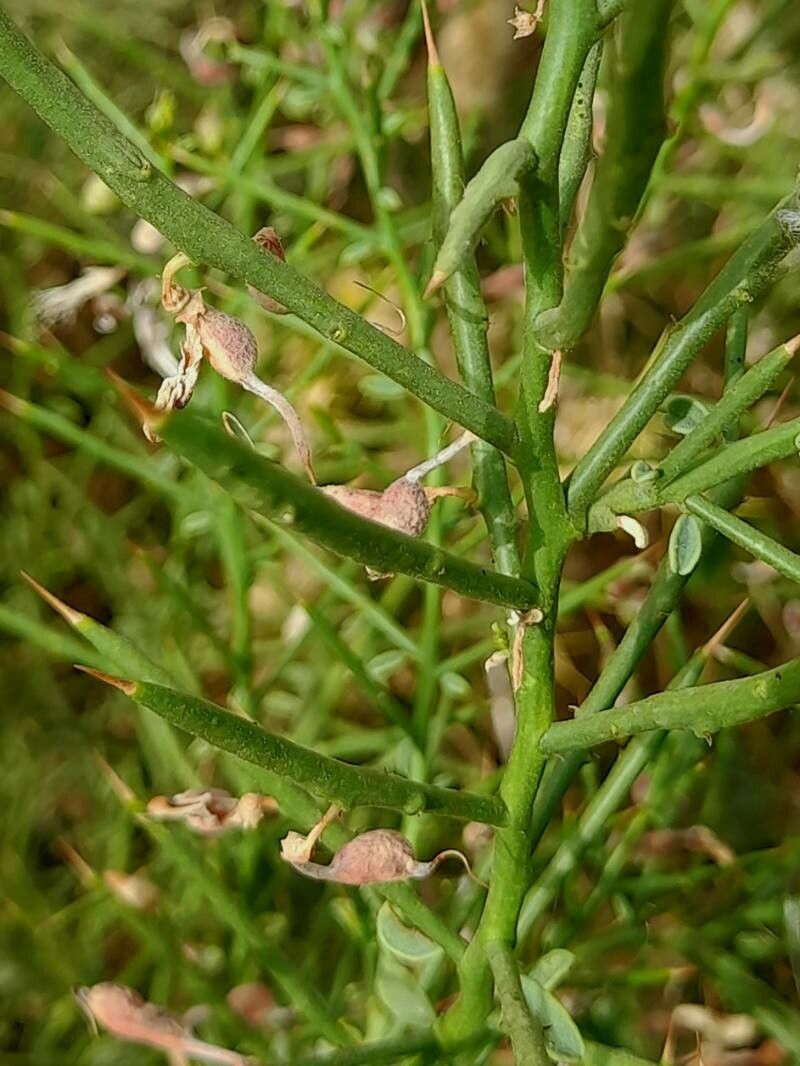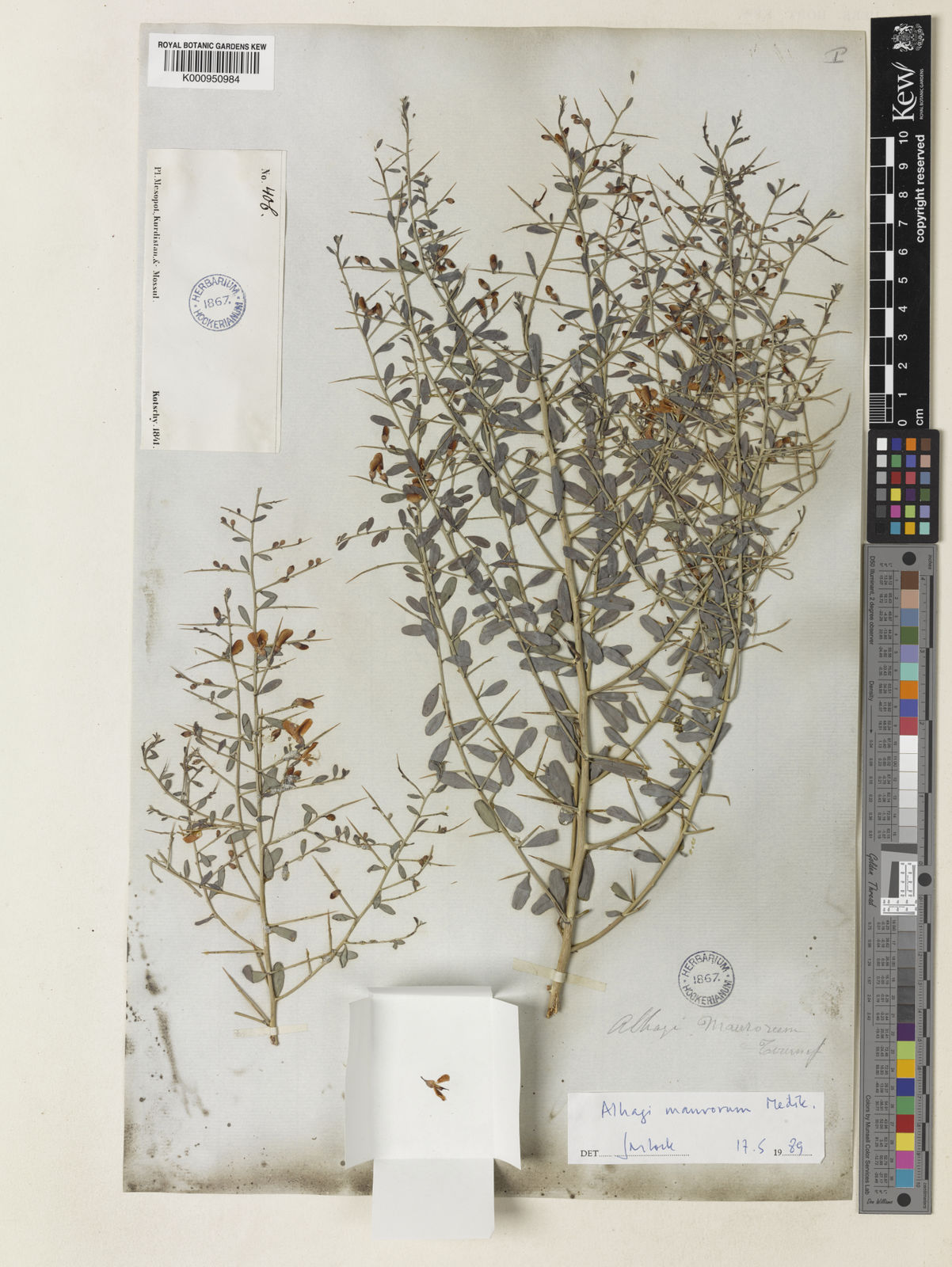Mares' Tail
alhagi maurorum
Also known as: ["Camel Thorn","False Mesquite"]
Overview
A perennial shrub native to Asia and the Mediterranean, known for its hardy nature and ability to thrive in arid conditions.
Benefits & Perks
["drought tolerant","wildlife attractant (bees, butterflies, birds)"]
Botanical Classification
| Phylum: | Magnoliophyta |
| Class: | Magnoliopsida |
| Order: | Fabales |
| Family: | Fabaceae |
| Genus: | Alhagi |
| Botanical Name: | Alhagi maurorum |
Plant Characteristics
Basic Information
- Category: Shrubs
- Suitable Location: drought-tolerant garden, rock garden, or xeriscaped area
- Suitable For:
- Is Weed: No
- Allergenicity: low
Environmental Needs
- Climate: {"temperatureRange":"–10–40°C"}
- Hardiness: {"zones":"5–9"}
- Misting: rarely required
- Drainage: Fast-draining to prevent waterlogging.
- Soil Type: Well-draining, sandy loam with organic matter. Tolerates poor soils but prefers fertility.
Maintenance Level
- Maintenance Level: very low
- Toughness Level: very high
- Pruning Frequency: Annually in late winter or early spring before new growth begins.
- Pruning Intensity: Moderate to heavy, depending on desired shape and size.
Care Details
Ideal Sunlight Coverage:
Full sun (6–8 hours of direct sunlight daily). Tolerates partial shade but may become leggy.
Sunlight Tolerance Tips:
Acclimate plants gradually to intense sunlight to prevent scorching. Indoors, place near a south-facing window; outdoors, ensure unobstructed light exposure.
Care Requirements
Care Difficulty
easymoderate
Sunlight
full sun
Rotate plant weekly for even growth; use shade cloth in extreme heat to prevent leaf burn; avoid sudden light changes.
Watering
every 7–10 days during active growth, less frequently in winter
Water thoroughly until runoff, allow soil to dry between waterings, and avoid overwatering to prevent root rot.
Soil
well-drained, sandy or loamy soil
pH: Slightly alkaline to neutral (pH 6.5–7.5).
Avoid heavy clay soils; amend with grit if needed; test pH periodically.
Temperature
Thrives in warm conditions (65–85°F or 18–29°C). Tolerates mild frosts but prefers stable warmth.
Avoid sudden temperature shifts; protect from frost; maintain consistent warmth during active growth.
Fertilizing
every 4–6 weeks during spring and summer
Fertilize only during active growth; flush soil occasionally to prevent salt buildup; use organic options like compost for slow release.
Propagation
Methods
Stem cuttings or division. Stem cuttings root readily in warm conditions.
Step-by-Step Propagation Guide
- Take 4–6 inch cuttings.
- Remove lower leaves.
- Dip in rooting hormone.
- Plant in medium.
- Keep moist and warm.
Best Time: Spring or early summer when the plant is actively growing.
Environment
Warm (70–75°F or 21–24°C), high humidity (70–80%), and bright indirect light.
Medium
Well-draining mix of perlite and peat moss or cactus soil.
Hormone
Rooting hormone is recommended to speed up root development.
Timeline
Roots develop in 3–4 weeks; new growth appears in 6–8 weeks.
Tools Needed
Pruning shears, rooting hormone, small pots, misting spray bottle.
Quick Tips
Use healthy, non-flowering stems; maintain consistent moisture; provide bottom heat for faster rooting.
Pruning & Repotting
Pruning Guide
Method
Selective cutting of stems to shape the plant; remove crossing or weak growth.
Pruning Plan
Prune to control size, encourage bushiness, and remove dead or overgrown stems.
Tools
Pruning shears, loppers, gloves, disinfectant.
Checklist
Disinfect tools; prune during dormancy; remove deadwood; shape evenly.
Repotting Guide
Best Season
Early spring before active growth starts.
Pot Size
One size up (e.g., from 4-inch to 6-inch pot); ensure good drainage holes.
Method
Remove plant gently; trim roots if needed; place in a slightly larger pot with fresh, well-draining soil; water lightly.
Suggestions
Repot every 2–3 years or when roots fill the container. Necessary to refresh soil and provide space.
Checklist
Check root bound status; use fresh soil; ensure drainage; water sparingly post-repotting.
Advanced Care Tips
Watering Mastery
Watering Checklist
Check soil moisture before watering; water deeply; ensure drainage; adjust frequency seasonally.
How to Apply Water Properly
Water directly at the root zone, ensuring even saturation to a depth of 6–8 inches. Allow excess water to drain freely; water early in the morning to minimize evaporation.
Watering Schedule Tips
Water deeply once every 7–10 days during active growth in spring and summer; reduce frequency to every 3–4 weeks in fall and winter. Adjust based on rainfall and soil dryness.
Soil Improvement
Add perlite or coarse sand for drainage; incorporate compost for fertility; ensure aeration with organic matter.
Temperature Stress Management
Signs of Temperature Issues
Chlorosis or wilting in excessive heat; stunted growth or leaf drop in cold stress.
Cold Stress
Low temperatures slow growth and may cause leaf drop or dieback, especially below 20°F (-6°C).
Solution: Protect with frost cloth or move to a sheltered location; mulch heavily to insulate roots.
Hot Stress
Excessive heat can lead to leaf scorch, wilting, or reduced flowering if water and light are not managed.
Solution: Provide partial shade during peak heat, increase watering, and ensure good air circulation.
Fertilizing Guide
Fertilizing Checklist
Check growth phase; use diluted fertilizer; avoid winter feeding; monitor for salt buildup.
Fertilizing Method
Use a balanced, slow-release fertilizer (10-10-10) in spring and summer, diluted to half strength monthly. Avoid fertilizing in fall and winter.
Common Problems & Solutions
Toxicity Warning
Cats
ToxicCats are susceptible to toxicity from Alhagi maurorum upon ingestion. The plant's toxic compounds can cause severe gastrointestinal irritation and systemic effects, leading to significant health issues in felines.
⚠️ Symptoms:
🌿 Toxic Parts:
⚡ Toxic If:
if eaten
Dogs
ToxicIn dogs, ingestion of Alhagi maurorum can lead to severe gastrointestinal upset and systemic toxicity due to the plant's lectins and other harmful compounds. These substances disrupt normal digestive processes and can cause significant distress.
⚠️ Symptoms:
🌿 Toxic Parts:
⚡ Toxic If:
if eaten
Humans
ToxicAlhagi maurorum contains toxic compounds that can cause significant physiological distress upon ingestion. The plant's lectins and other bioactive compounds interfere with normal cellular functions, leading to gastrointestinal and systemic effects.
⚠️ Symptoms:
🌿 Toxic Parts:
⚡ Toxic If:
if eaten
Frequently Asked Questions
Q: Is Alhagi maurorum suitable for xeriscaping?
A: Yes, it is highly drought-tolerant and well-suited for xeriscaping.
Q: Can Alhagi maurorum be used in traditional medicine?
A: Historically, it has been used in traditional medicine for its diuretic properties, though modern use is limited.
Q: Does Alhagi maurorum attract wildlife?
A: Yes, it attracts bees, butterflies, and birds due to its nectar-rich flowers.
Quick Reference
| Family: | Fabaceae |
| Care: | easy |
| Light: | full sun |
| Water: | every 7–10 days during activ |
Get Expert Care Tips
Download the Plantious app for personalized care reminders and plant identification!
Google Play App Store








